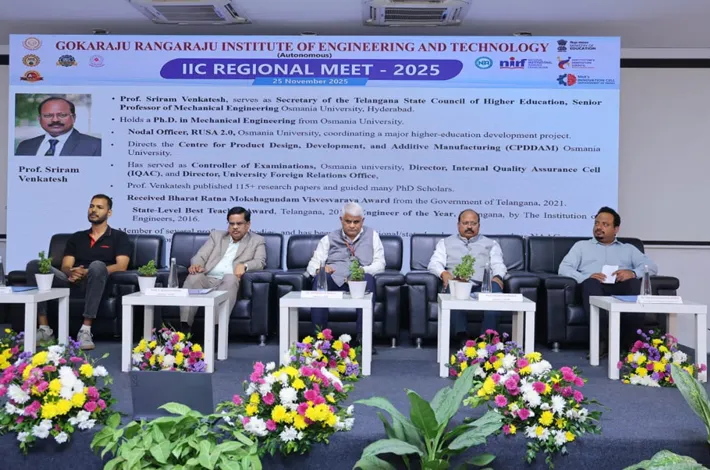India–US trade deal nearing surface!
24-11-2025 12:00:00 AM

Prime Minister Modi’s economic model continues to gain traction abroad.The days of diplomatic hide-and-seek are over. Security, rare earths, critical minerals, agriculture, textiles, electronics, AI, services, jobs, pharmaceuticals—everything is intertwined
Palazhi Ashok Kumar MUMBAI
After eight months of grandstanding, stalled meetings and diplomatic brinkmanship, India and the United States appear ready at last to seal an interim trade pact—one that insiders now call “not optional, but unavoidable”. What began in March 2025 as a routine negotiation has since turned into a geopolitical tug-of-war, fuelled by President Trump’s fiery campaign for “reciprocal tariffs”. More than half a dozen rounds—split between Washington’s power corridors and New Delhi’s strategic backrooms—have produced little beyond irritation.
Trump’s repeated claims of a “deal soon”, “deal ready”, “very close” have worn thin across world capitals. “Markets, industry and policymakers have been strung along for too long,” said the former chairman of a BSE listed firm. “The patience of an entire economy has been stretched.” Now, however, the deadlock may finally be easing.
A senior Washington insider told FPJ Money late Saturday: “An interim deal is imminent. Both sides are exposed, and the days of diplomatic hide-and-seek are over. Security, rare earths, critical minerals, agriculture, textiles, electronics, AI, services, jobs, pharmaceuticals—everything is intertwined.” At the heart of the impasse lies what diplomats privately call “Modinomics versus Trumponomics”—two clashing economic worldviews.
“Washington’s tariff bombardment—25% on Indian exports, then an abrupt leap to 50% over India’s energy links with Russia—has only sharpened the divide. Meanwhile, Modi’s economic model continues to gain traction abroad. Modinomics@11, marking his 11 years as Prime Minister and 24 years in elected office, has found eager audiences across America, Europe and the Asia–Pacific,” a retired diplomat opined.
In the India-US trade deal negotiations, Washington had repeatedly sought removal of tariffs on most industrial goods, opening of the farm and dairy sectors, including access for genetically modified corn and soybeans, unrestricted cross-border data flows, relaxed e-commerce and intellectual property rules, and larger commitments to buy US oil, LNG, and defense equipment. In exchange, the US had offered reducing its tariffs on Indian exports from 25% to roughly 15–17%.
A senior retired IAS official involved in trade policy offered a blunt warning: “If the India–US deal slips again, India must unleash the full strength of its domestic market. Any remaining red tape—across every sector—must be cut. Citizens must feel pride in administration at every level. States must rise. The opportunity lies within.”
The global climate is growing harsher. Soaring US tariffs have pushed Chinese manufacturers to divert goods meant for America into emerging economies—including India. This surge of low-cost shipments threatens to overwhelm domestic producers already struggling to match China’s relentless price-to-quality edge.
S&P Global, expects governments across Asia to deploy stronger shields to defend industry. Steel is already on the frontline. India, like many others, has been forced to counter a fresh wave of cheap Chinese steel—a flood that has only intensified since August amid rising US duties.
“In 2026, results of the US midterm elections, and the appointment of a new Fed chair could drive step changes in the broader macro environment. Effects of high tariffs and slowing US growth could complicate the Asia-Pacific and global economic outlook. If US court rulings force a retreat on the US tariffs in question, this could present an upside to the region (Asia-Pacific); the loss of tariff income to the Trump administration could yet be another blow to mounting US government indebtedness and the US dollar more broadly,” S&P Ratings warns. The ongoing effects of U.S. tariffs continue to reshape trade across Asia-Pacific, driving market and supply-chain diversification.
This will test corporates as they try to adapt to trade uncertainties and shifts in policy. Interest rates remain a watchpoint. They will likely decline further but stay well above the exceptionally low levels seen in the early 2020s. The effect on asset prices and inflation will still be front of mind. A breakthrough with Washington could reset global trade dynamics. Another collapse could push India to turn decisively inward, harnessing the power of its vast home market and reshaping its economic future from within. Either way, the world is watching—and the next move will be momentous.








